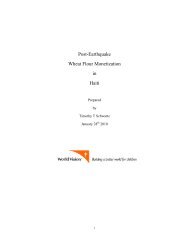Food Consumption Patterns Part 2
You also want an ePaper? Increase the reach of your titles
YUMPU automatically turns print PDFs into web optimized ePapers that Google loves.
113<br />
Annex 3: Most Nutritional <strong>Food</strong>s Free-lists<br />
Before we get into the categories, we here review the original source we use to develop the<br />
categories for further analysis and exploration. The first two was the freelist survey. The survey<br />
involved interviewing 40 women and 13 men between the ages of 17 and 73 with average age of<br />
33 years old. The questions were what are the most nutritious foods for, a) babies, b) children c)<br />
pregnant women, d) women, and e) men. viii<br />
Table A3-1: Respondents per category<br />
Baby Children Pregnant Woman Man<br />
53 47 47 45 48<br />
The following steps were taken to simplify the data for analysis. In doing so important features of<br />
the data became evident and must be noted here. The distinctions help describe the data and suggest<br />
further areas of investigation in the subsequent research.<br />
<br />
<br />
<br />
<br />
<br />
<br />
<br />
<br />
<br />
In first level analysis mixed foods were separated and the dimension of mode of preparation<br />
such as pureed beans vs beans kole (mixed with grains) was omitted<br />
If a mixed food was specified, such as rice and beans, or rice and vegetables, the categories<br />
were broken down and listed as their constituent entries. Thus, rice and beans became, rice<br />
and then beans. Spaghetti and milk became spaghetti and then milk. The only exception<br />
was bouyon (stew), a concoction so frequently mentioned that we kept bouyon as if it were<br />
a single food. A justification for this is that bouyon included several of the most commonly<br />
cited foods that were listed apart from bouyon itself, therefore keeping it as a single food<br />
type did not effect the frequency of citations for the ingredients<br />
Smoked herring (imported) became fish<br />
All poultry and meats were put under meat<br />
All malt drinks, extrait de malta and guiness, were put in the single category of malta<br />
All energy drinks were put in the single category of energy drinks<br />
All vegetable and fruit juices were put under natural juice vs processed juice (but not the<br />
blended starches mentioned above). The most venerated juices in terms of nutrition are<br />
lime and passion fruit. Carrots have a very high place on the list of respected nutritional<br />
foods and it were often cited as a juice in which cases we translated it not as “natural juice”<br />
but, because it is a vegetable, as carrots. This logic may or may not be appropriate<br />
All non-starchy vegetables and greens were combined together even though among popular<br />
class Haitians they are distinct categories (legim vs fey)<br />
When respondents said labouyi with no qualifier we interpreted it to be understood as<br />
‘wheat flour.’ But it may in times have been used as a catch all
















